#dynamics365partner
Explore tagged Tumblr posts
Text
#Business is never the same. Business is always changing and evolving! #Microsoft365 #Dynamics365 and #Office365 bring the best of #MicrosoftEnterprise #technology and #cybersecurity to the forefront of #Business . Learn more CLICK HERE: https://techsolworld.com/subscriptions
Email: [email protected] or Call (800)998-2792
#microsoft#microsoft dynamics 365#MicrosoftSolutionsProvder#MicrosoftGoldPartner#MicrosoftCSP#MicrosoftMSP#MicrosoftLSP#MicrosoftEnterprise#MicrosoftReseller#MicrosoftLicenseReseller#MicrosoftEnterpriseAgreement#Microsoft365#Office365#Dynamics365#Microsoft365Partner#Dynamics365Partner#Office365Partner#MicrosoftAppSource#MicrosoftPartnerNetwork#TechnologySolutionsWorldwide#MicrosoftBusinessSubscription#MicrosoftLocalPartner#BestMicrosoftPartner#MicrosoftJamaica#MicrosoftPartnerBahamas#MicrosoftPartnerAruba#MicrosoftPartnerLicensing#MicrosoftDistributor#Microsoft365Business#Microsoft365BusinessBasic
1 note
·
View note
Text
Microsoft Dynamics 365 Partner | CRM & ERP Solutions
Cloudmonte is the leading Microsoft Dynamic 365 Partner. Contact us for ERP & CRM development, implementation, upgrade, and consulting services.
visit : https://cloudmonte.com
#microsoftdynamicpartner#microsoftdynamic365partner#dynamics365implementationcompany#Msdynamics365#Dynamics365partner#microsoftdynamics365partner
1 note
·
View note
Text
Microsoft Intune Powers Scalable IT for Wuxly
IFI Techsolutions modernized Wuxly's IT using Microsoft Intune ensuring smooth, scalable and flexible operations.
0 notes
Text
Microsoft Dynamics 365 Partners & Consulting Companies
Making it easier for you to create exceptional customer experiences by connecting your teams, processes, and data across your organization. Microsoft Dynamics 365 is a revolutionary suite of smart, cloud-based business applications that includes both ERP and CRM.
For More Info-https://ifi.tech/leading-microsoft-dynamics-365-partners-consulting-companies/
0 notes
Text
Helpdesk CRM | Customer Service Software - CRM Online
Looking for a customer service software in and around the UK, CRM offers one of the best software.CRM Online Offers Cloud-based Helpdesk CRM that helps your business develop relationships with customers. Official Odoo and Microsoft Dynamics 365 partner. Contact for further details.
Website: https://www.crm-online.co.uk/industries/support-helpdesk-services/
Contact: +44 (0)203 7622 312
#CRM#CRMonline#CRMtool#UK#topCRM#topCRMsystems#CRMmanufacturer#CRMUK#helpdeskCRM#CustomerServiceSoftware#CloudbasedHelpdesk#OfficialOdoo#MicrosoftDynamics365#Dynamics365partner
0 notes
Text
Microsoft Dynamics 365 Partner in USA, Canada, India

Microsoft Dynamics 365 is the leading enterprise resource planning (ERP) and customer relationship management (CRM) software solution. It helps businesses of all sizes to streamline their operations, increase productivity, and grow their profitability. To make sure that you get the most out of this powerful platform, it is important to find a reliable Microsoft Dynamics 365 Partner in USA, Canada, & India or any other region you are operating in. With their expertise and experience in working with Dynamics 365, they can help you maximize its potential and ensure that it meets all your business requirements.
0 notes
Text
How Manufacturing Industry Transformed using Microsoft Dynamics 365
The future of manufacturing will be defined by the quality of investments companies are making today In the not too distant past, efforts in manufacturing to optimize productivity and increase customer satisfaction were viewed as separate endeavors. Today, the convergence of physical and digital trends is disrupting these kinds of assumptions. Manufacturers today care about integrated digital and physical systems, improved visibility, increased efficiency, additional flexibility, and lower costs. They want to connect equipment and factories, leveraging data from the factory floor to the customer call center to improve every aspect of their operations. But this is just the beginning. Digitization is fundamentally changing the way manufacturers do business, enabling a customer-centric approach while optimizing operations. Digitally empowered manufacturers engage customers throughout the product lifecycle from design to field service. They sell value-add services to complement the product sales, opening new revenue streams and strengthening their customer relationships. And they are revolutionizing delivery of these differentiated services, using technology like augmented reality to combine the eyes of a technician in the field with the insights of an expert back at headquarters. Capitalizing on these trends isn’t limited to large, well-resourced manufacturers. Across all kinds of manufacturing operations, the opportunity to digitize and transform your business has never been more accessible. Imagine your business transformed The Microsoft vision for supporting digital manufacturing embraces the seismic shifts in the industry today. We’ve created solutions that provide a unified and flexible approach across front office and production floor processes. Our approach enables transformation in six ways:
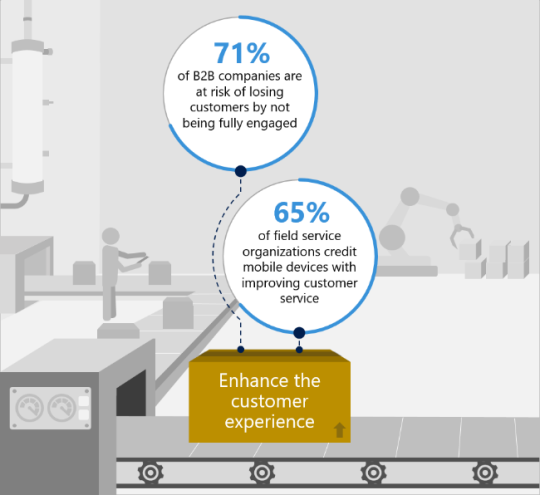
Optimize supply chain operations through better visibility and collaboration By collecting, integrating, and visualizing global supply chain data worldwide, manufacturers gain better visibility into their operations from production to sales. For example, one of the world’s largest industrial automation firms found that by automating the collection and analysis of data from remote installations across the petroleum supply chain, they strengthened their competitive advantage with a faster time to market. Improved access to supply chain data is also the basis for better collaboration across production, supply, service, and sales. Streamline the management of assets, products, and production With a consolidated view that unifies process oversight and provides real-time insight, manufacturers can institutionalize efficiency gains and use connected devices to monitor and resolve issues remotely. One leading manufacturer of industrial robots enabled 24-hour continuous uptime using this approach. The additional insights into production and customer usage also allow manufacturers to provide value-added services like ongoing monitoring and proactive support.
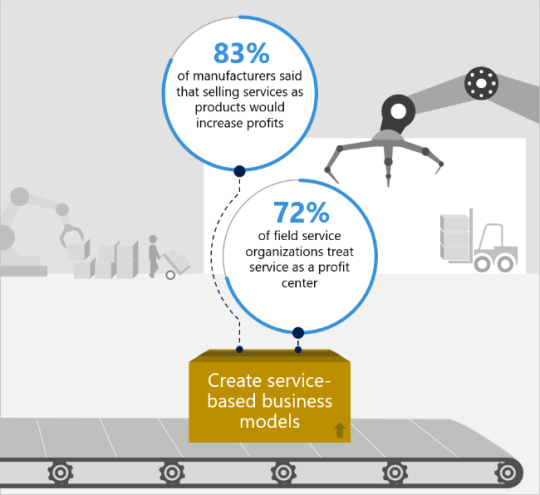
Engage customers in powerful new ways To deliver personalized and contextual engagement across any channel, manufacturers must provide customers with more visibility and build trust through fast and convenient responses. This engagement approach is built on a combination of predictive analytics, the ability to deliver value-added services at scale, and guided or self-directed service that’s relevant to customer needs. With the implementation of a connected platform for sales through service, a leading home technology manufacturer not only solved potential problems remotely before customers ever felt the impact, but provided custom differentiated offerings based on unique customer usage and purchasing history. Transform service centers into profit centers Thanks to the ever-decreasing cost of IoT sensors, sophisticated mobile devices, and cloud-based data aggregation, manufacturers can improve service quality and margins by offering remote monitoring and proactive maintenance services that supplement break/fix support. By more intelligently coordinating technicians equipped with mobile and virtual reality tools, companies can leverage existing expertise and minimize costly engagements. A leading tire service and manufacturing company found that by combining customer records, technician availability, and back-end inventory in a single mobile-friendly system, it could provide a seamless user experience as well as improve its service delivery.
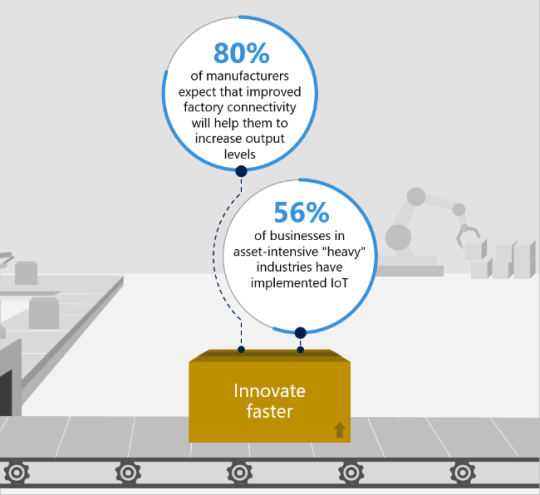
understand their business more deeply, from customer usage through supply chain sourcing and production. With IoT-enabled parts, assets, and products, manufacturers can gain the insights needed to innovate. Data from connected products and equipment can empower developers, engineers, and technicians to collaborate. For example, teams can identify overengineered or faulty components and track product usage in the field to improve future designs. When a leading information and communication technology company implemented remote monitoring, they decreased time to production as well as accelerated the cycle of innovation using a data-driven approach. Empower employees to work more effectively When a company can provide 360-degree views of customer assets and work order history, technicians are empowered by a better understanding of not only the job in front of them, but of other similar and successful field service engagements. This goes hand in hand with empowering service agents to provide instant feedback, using machine learning to find and follow similar cases for successful troubleshooting, and scheduling a visit or evaluation. A leading auto manufacturer wanted to save money by unifying their siloed customer service and customer engagement while providing employees with better tools to understand customer sentiment. To accomplish this, it implemented a system to connect production and project management with their customer relationship management systems in order to deliver personalized service and recommendations to their customers. Introducing Microsoft Dynamics 365 For manufacturers, Microsoft Dynamics 365 ends the artificial divide between CRM and ERP systems and supplements necessary capabilities with rich analytics, embedded intelligence, and the convenience people expect from consumer apps on their phone or tablet. Dynamics 365 unites the front office and the back office with a single end-to-end system for managing every aspect of your business, at the pace and scale that’s right for you. Digital transformation isn’t accomplished overnight and leveraging current investments is a key component of any successful approach. With Microsoft, you can optimize across all your processes while laying the foundation for connecting advanced technology in the future. Blog reference: https://cloudblogs.microsoft.com/dynamics365/bdm/2017/05/30/manufacturing-transformed-microsoft-dynamics-365 Read the full article
#automotivemanufacturingerp#axpartner#axpartnerinuae#crmforhospitality#crmformanufacturingindustry#crmimplementationpartner#dynamics365partner#Dynamics365partnerinindia#dynamics365partnerinsouthafrica#dynamics365partnerinuae#dynamics365partnerportal#dynamicsaxpartner#dynamicsaxpartnerindelhi#dynamicsnavpartner#dynamicsnavpartnerinethiopia#dynamicsnavpartnerinkolkata#dynamicsNavisionpartner#dynamicspartnerinIndia#dynamicspartnerinUAE#erpforautomotivemanufacturing#erpforelectronicsmanufacturing#erpforhospitality#erpforhospitalityindustry#erpformanufacturingindustry#erpforsteelmanufacturing#foodmanufacturingerp#hospitalityerpsoftware#HospitalityERPSolution#hospitalitymanagementsolution#IBMTrainingPartnerIndia
0 notes
Text
Migrating from Salesforce to Dynamics 365 – Here’s everything you need to know

Dynamics is the best solution for businesses that want to drive growth through a customer-centric approach.
Migrating from Salesforce to Dynamics 365 – Reasons, advantages, and key considerations
Customer Relationship Management (CRM) has seen incredible growth since 2017 till now as per Gartner. In 2017 and 2018, Gartner reports mentioned that CRM has become the largest software market; now, the Customer Relationship Management market is predicted to grow at a 13.7% Compound Annual Growth Rate (CAGR) through 2021. While implementing a CRM for an organization can have a profound positive impact, sometimes, despite your best efforts, a CRM may turn out to be a poor fit for your business. Then the companies have to acknowledge that it is not working efficiently and start looking for a new CRM solution that best fits. As a CRM and ERP, Microsoft Dynamics is the best solution for businesses that want to drive growth through a customer-centric approach. Microsoft Dynamics is one of the largest platforms implemented with a 67% growth rate and a 47% revenue. More organizations are switching from Salesforce to Dynamics to enjoy the flexibility and compatibility of working within the Microsoft suite products they use across their business. There are many strong reasons that more companies take this decision to shift from Salesforce to Dynamics.

Reasons for businesses to shift from Salesforce to Dynamics 365
Leveraging the larger Microsoft ecosystem of solutions and adopting more applications over time.
Strategic Microsoft partnership initiative.
Lesser costs compared to Salesforce.
Significant investments and ROI from Microsoft on these organizations.
The lower total cost of ownership (TCO) and maintenance.
Inability to meet growing business requirements with the current system.
Additional functionalities that Salesforce CRM does not offer.
Easy integration with Microsoft products like Word, Office 365, PowerPoint, Excel, Outlook, etc.
Quickly scale the usage of the products and apps they need to use.
Microsoft PowerApps and Power BI.
No extra cost on basic add-on functionalities
Advantages of Microsoft Dynamics 365
Get up-to-date analytics: Microsoft Dynamics enables you to gather data that keeps you informed and up to speed. This allows you to make better decisions by identifying and prioritizing key opportunities.
Cut down delays with centralized information: Centralized information in the system can ensure you can access information across the organization. It helps you cut down delays experienced by your customers by helping you save time by reducing search and follow-up time.
Multi-channel marketing capabilities: Microsoft Dynamics 365 offers marketing capabilities that enable you to determine the types of messages you should send your customers through their preferred channels and enhance your marketing ROI.
AI-informed processes: AI-fuelled CRMs provide real-time insights into customer behavior, identifying buying patterns that turn into conversion opportunities. Because of Microsoft’s investment in AI and machine learning, they continue to be a leader in this part. Dynamics 365 is such AI-powered platform that helps increase productivity and help you grow through advanced insights.
Exceptional customer experiences: Microsoft Dynamics 365 can help you improve your customer experience by using data and intelligence. This enables you to provide customer service that meets your customer’s expectations, builds trust, and keeps them loyal.
Scalable and adaptable to the legacy system: Microsoft Dynamics CRM solution suite flexible to your legacy system, but it also customizes your security levels to fit your needs. And this, of course, is scalable as your business grows.
Deployment options: With Dynamics 365, you can choose whether you want an on-premise solution or through the cloud. If you are coming from Salesforce, having more than one deployment option with CRM for Dynamics 365 is a luxury.
An important fact is that migration from Salesforce to Microsoft Dynamics 365 can be complex and even disrupt your business. So if you’re planning to migrate from the Salesforce system to Dynamics 365, here’s everything you must know about migrating from Salesforce to Dynamics 365 with better results.
Key things you need to consider before migrating from Salesforce to Dynamics 365
Planning: The first best practice you can put into action to ensure your switch from Salesforce to CRM for Dynamics 365 successfully gets the right parties and people involved early on in the planning process to have champions and advocates aligned when the switch is made.
Change management: When migrating to Dynamics 365, change management requires an abundance of upfront planning. This way, the actual switch from Salesforce to Microsoft Dynamics 365 follows the detailed plan from data migration to user adoption.
Deployment options for Dynamics 365:
Dynamics 365 Online – It is the most similar to your Salesforce CRM deployment. The online deployment option provides you the flexibility to access your CRM data from anywhere and on any device connected to the internet.
Dynamics 365 On-Premises – An On-Premises deployment is for deploying your CRM system on your servers within your own data center. The most significant benefit to an On-Premises deployment is direct access.
Dynamics 365 in a Private Cloud – This deployment option for Dynamics 365 solution is similar to on-premise. But, instead of your server, it would be your Partner’s private data center. The most significant benefit to deploying in a Private Cloud is that you don’t have to manage the infrastructure of managing services.
Data migration: Businesses today have to deal with vast amounts of data, because of which big data and data migration have become topics of the utmost importance for business leaders. Any business must maintain top-level data quality. When shifting from Salesforce to Dynamics 365, you may want to execute the straight migration to be running on your new system as quickly as possible before adding new functionality. The data migration process can be challenging.
But, there is a way to plan your data migration to secure a smooth and seamless data migration process in a few steps.
Plan: Assess and find out the data sources and determine what needs to be migrated. This step is significant, and it helps determine the most suitable migration.
Map: Once done determining, map fields from the source system to the corresponding target fields/entities in CRM.
Extract: Post to past steps, extract the data from the source systems.
Transform: Transform the data (including changing data types, modifying formats, and at times, data cleansing and de-duplication) to be compliant with Dynamics CRM.
Load: Import the data into Dynamics 365 system through automated scripts, tools, or manually.
Verify: The last and essential part of the data migration process is to verify if the data is migrated successfully by comparing record counts, spot-checking records, or developing validation routines.
Migrate to Dynamics and accelerate your business now!
From what we have seen in this article, migrating to Dynamics 365 exposes your business to a world of better possibilities. It comes with rich features and extensive capabilities to accommodate every company with their unique business need. Microsoft’s integrations with ERP, Office 365, Suite, Power BI, and Flow is an added advantage when we aim for business growth with Dynamics 365.
As a Dynamics partner, we can support you with a smooth Salesforce migration to Dynamics 365. Our consultants will help you throughout the planning, migration, data preparation, and implementation with years of technical experience in data migration and Dynamics migration. To know more, talk to us.
0 notes
Text
Enhance your #productivity with #Microsoft empowered #software #technology . This includes #Dynamics 365 #Microsoft365 #PowerPlatform #SCCM #Intune and much much more. #Mobilize your #workforce and stop them from being stagnant. Get the latest and greatest in #Microsoft #products and #services .
#Microsoft Partner #MicrosoftSolutionsPartner #MicrosoftAppSource #Microsoft365Partner #Dynamics365Partner #PowerBIPartner #MicrosoftCSP #MicrosoftReseller #MicrosoftLicenseReseller #TechnologySolutionsWorldwide
Visit https://techsolworld.com/subscriptions
Call (800)998-2792
#microsoft#microsoftappsource#microsoftenterprise#microsoftgoldpartner#technology solutions worldwide#microsoftreseller#microsoft appsource#technologysolutionsworldwide#microsoftlicensereseller#microsoft dynamics 365#microsoft mobility#microsoft partner network#best microsoft partner#local microsoft partner#find a microsoft reseller#find a microsoft partner#microsoft license discount#microsoft 365 partner#get the best price on microsoft business#microsoft business licenses#microsoft discount code#microsoft discount coupon#microsoft business subscriptions#best price on m365 business#get microsoft business license#find a partner on microsoft appsource#find a local partner on microsoft partner network#find a dynamics 365 partner#find a microsoft 365 partner
1 note
·
View note
Text
How Manufacturing Industry Transformed using Microsoft Dynamics 365
The future of manufacturing will be defined by the quality of investments companies are making today In the not too distant past, efforts in manufacturing to optimize productivity and increase customer satisfaction were viewed as separate endeavors. Today, the convergence of physical and digital trends is disrupting these kinds of assumptions. Manufacturers today care about integrated digital and physical systems, improved visibility, increased efficiency, additional flexibility, and lower costs. They want to connect equipment and factories, leveraging data from the factory floor to the customer call center to improve every aspect of their operations. But this is just the beginning. Digitization is fundamentally changing the way manufacturers do business, enabling a customer-centric approach while optimizing operations. Digitally empowered manufacturers engage customers throughout the product lifecycle from design to field service. They sell value-add services to complement the product sales, opening new revenue streams and strengthening their customer relationships. And they are revolutionizing delivery of these differentiated services, using technology like augmented reality to combine the eyes of a technician in the field with the insights of an expert back at headquarters. Capitalizing on these trends isn’t limited to large, well-resourced manufacturers. Across all kinds of manufacturing operations, the opportunity to digitize and transform your business has never been more accessible. Imagine your business transformed The Microsoft vision for supporting digital manufacturing embraces the seismic shifts in the industry today. We’ve created solutions that provide a unified and flexible approach across front office and production floor processes. Our approach enables transformation in six ways:
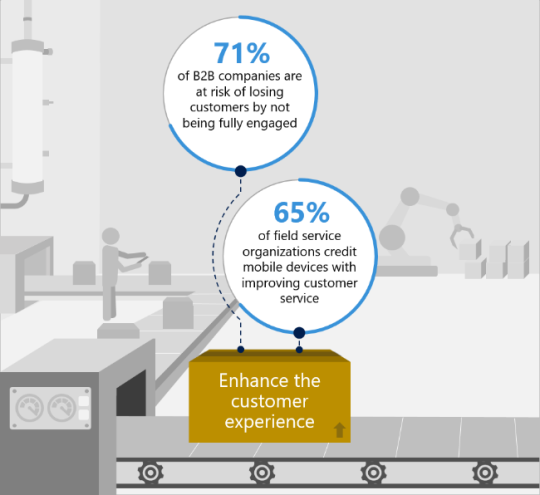
Optimize supply chain operations through better visibility and collaboration By collecting, integrating, and visualizing global supply chain data worldwide, manufacturers gain better visibility into their operations from production to sales. For example, one of the world’s largest industrial automation firms found that by automating the collection and analysis of data from remote installations across the petroleum supply chain, they strengthened their competitive advantage with a faster time to market. Improved access to supply chain data is also the basis for better collaboration across production, supply, service, and sales. Streamline the management of assets, products, and production With a consolidated view that unifies process oversight and provides real-time insight, manufacturers can institutionalize efficiency gains and use connected devices to monitor and resolve issues remotely. One leading manufacturer of industrial robots enabled 24-hour continuous uptime using this approach. The additional insights into production and customer usage also allow manufacturers to provide value-added services like ongoing monitoring and proactive support.
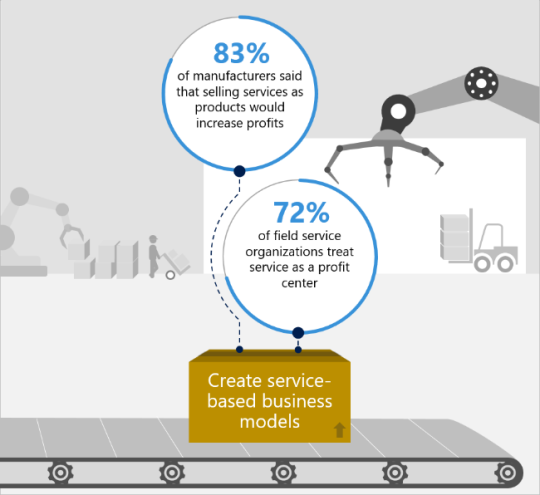
Engage customers in powerful new ways To deliver personalized and contextual engagement across any channel, manufacturers must provide customers with more visibility and build trust through fast and convenient responses. This engagement approach is built on a combination of predictive analytics, the ability to deliver value-added services at scale, and guided or self-directed service that’s relevant to customer needs. With the implementation of a connected platform for sales through service, a leading home technology manufacturer not only solved potential problems remotely before customers ever felt the impact, but provided custom differentiated offerings based on unique customer usage and purchasing history. Transform service centers into profit centers Thanks to the ever-decreasing cost of IoT sensors, sophisticated mobile devices, and cloud-based data aggregation, manufacturers can improve service quality and margins by offering remote monitoring and proactive maintenance services that supplement break/fix support. By more intelligently coordinating technicians equipped with mobile and virtual reality tools, companies can leverage existing expertise and minimize costly engagements. A leading tire service and manufacturing company found that by combining customer records, technician availability, and back-end inventory in a single mobile-friendly system, it could provide a seamless user experience as well as improve its service delivery.
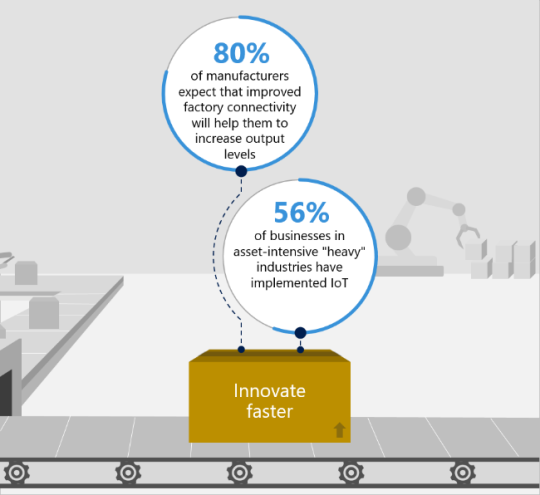
understand their business more deeply, from customer usage through supply chain sourcing and production. With IoT-enabled parts, assets, and products, manufacturers can gain the insights needed to innovate. Data from connected products and equipment can empower developers, engineers, and technicians to collaborate. For example, teams can identify overengineered or faulty components and track product usage in the field to improve future designs. When a leading information and communication technology company implemented remote monitoring, they decreased time to production as well as accelerated the cycle of innovation using a data-driven approach. Empower employees to work more effectively When a company can provide 360-degree views of customer assets and work order history, technicians are empowered by a better understanding of not only the job in front of them, but of other similar and successful field service engagements. This goes hand in hand with empowering service agents to provide instant feedback, using machine learning to find and follow similar cases for successful troubleshooting, and scheduling a visit or evaluation. A leading auto manufacturer wanted to save money by unifying their siloed customer service and customer engagement while providing employees with better tools to understand customer sentiment. To accomplish this, it implemented a system to connect production and project management with their customer relationship management systems in order to deliver personalized service and recommendations to their customers. Introducing Microsoft Dynamics 365 For manufacturers, Microsoft Dynamics 365 ends the artificial divide between CRM and ERP systems and supplements necessary capabilities with rich analytics, embedded intelligence, and the convenience people expect from consumer apps on their phone or tablet. Dynamics 365 unites the front office and the back office with a single end-to-end system for managing every aspect of your business, at the pace and scale that’s right for you. Digital transformation isn’t accomplished overnight and leveraging current investments is a key component of any successful approach. With Microsoft, you can optimize across all your processes while laying the foundation for connecting advanced technology in the future. Blog reference: https://cloudblogs.microsoft.com/dynamics365/bdm/2017/05/30/manufacturing-transformed-microsoft-dynamics-365 Read the full article
#automotivemanufacturingerp#axpartner#axpartnerinuae#crmforhospitality#crmformanufacturingindustry#crmimplementationpartner#dynamics365partner#Dynamics365partnerinindia#dynamics365partnerinsouthafrica#dynamics365partnerinuae#dynamics365partnerportal#dynamicsaxpartner#dynamicsaxpartnerindelhi#dynamicsnavpartner#dynamicsnavpartnerinethiopia#dynamicsnavpartnerinkolkata#dynamicsNavisionpartner#dynamicspartnerinIndia#dynamicspartnerinUAE#erpforautomotivemanufacturing#erpforelectronicsmanufacturing#erpforhospitality#erpforhospitalityindustry#erpformanufacturingindustry#erpforsteelmanufacturing#foodmanufacturingerp#hospitalityerpsoftware#HospitalityERPSolution#hospitalitymanagementsolution#IBMTrainingPartnerIndia
0 notes
Text
THE TOP 10 REASONS WHY SMBs SHOULD INVEST IN THE CLOUD

Small to medium-sized businesses (SMBs) are lagging behind their enterprise counterparts when it comes to cloud adoption. With the new year (and new decade) fast underway, a recent Microsoft study showed that more than 96% of enterprises are using the cloud, compared to only 78% for SMBs. And while the use of cloud-based productivity apps like Office 365 has steadily grown among these smaller companies, their continued reliance on legacy software in key business applications such as ERP or accounting is impeding them from competing effectively with today’s top players. Given this situation, moving to the cloud should be an obvious priority for SMBs, but many myths and misconceptions still exist regarding the benefits of cloud technology. Below are the ten most crucial and game-changing benefits that SMBs have reported after investing in cloud solutions. 1 - Greater profit and ROI Simply put, companies that move to the cloud make more money. And not by a small percentage, either. SMBs that invest in the cloud report up to 25% growth in revenue and up to 2x the profits over those who don’t. Embracing the cloud is simply a better path to faster growth. Additionally, cloud deployments provide a greater return on investment (ROI) than traditional on-premises software projects, especially in ERP and CRM. For example, Nucleus Research determined that companies that use Microsoft Dynamics 365 see a return of $16.97 for every $1 spent. That’s well above the average for on-premise ERP and CRM applications. 2 - Lower costs and CapEx Cloud subscription models eliminate up-front capital expenditures (CapEx) like the high cost of hardware and software licenses for projects like ERP software implementations. They also eliminate server and infrastructure setup, update, and maintenance fees—not to mention the resources saved on software upgrades, energy costs, and underutilized computing resources 3 - Unparalleled business flexibility Cloud software allows small businesses to remain always-on regardless of location. In today’s mobile and cloud-first world, the ability to be productive on any phone, tablet, or laptop provides the flexibility required to quickly adapt to changing information and business needs. This means more agile operations and happier customers 4 - Faster IT innovation The hassle and cost of routine IT maintenance tasks can be effectively offloaded to the cloud, enabling IT resources to focus on more strategic tasks like addressing problems, improving user experiences, fostering user adoption and best practices, and getting more value out of systems and processes 5 - Seamless, automatic software updates With cloud computing, all software updates are handled automatically, so critical systems always have the latest functionality and security features. This effectively ensures that all the benefits of a vendor's ongoing R&D nvestments are transferred to their customer's business, without that business having to dedicate any time or additional resources 6 - Cost-effective scalability SMBs need increased flexibility to grow and scale without hassle. With the cloud, as an SMB adds users, generates more transactions, or adds more data, services dynamically scale to manage the workload. This eliminates the need to pay for more hardware or maintenance to support business growth. As a bonus, SMBs only use the energy they need for their cloud apps. Since servers aren’t running idle waiting to be utilized, operations become more energy efficient, reducing the carbon footprint of the business. 7 - Improved collaboration and productivity Digital, cloud-based workspaces offer the opportunity to collaborate more effectively and remove data silos to enable greater employee productivity. Additionally, cloud-based office productivity suites and all-in-one business management solutions possess integration capabilities that simply can’t be matched by on-premises software. Cloud computing also allows teams to be productive, regardless of their location. This enables businesses to offer flexible working arrangements that create a healthier work/life balance and happier employees without sacrificing productivity. 8 - Seamless software integration Cloud applications are typically compatible with Application Programming Interfaces (APIs) that simplify integration, while automation tools like Microsoft Flow facilitate stitching them together without any custom code. Data and systems can be connected like never before, resulting in new levels of speed and efficiency. 9 - Superior security and data protection Small businesses are the most common victims of security breaches. In a recent study by ComScore, over 40% of small businesses were worried about data security before moving to the cloud. After making the switch, 94% of businesses reported security benefits they had been unable to achieve with their previous on-premises resources. Furthermore, physical hardware protection has always been a challenge for SMBs. Laptops get lost or stolen all the time. In addition to the replacement costs, there is the even greater cost of losing important or sensitive data. When storing and backing up data in the cloud, however, data is available and protected regardless of what happens to personal devices. 10 - Increased competitiveness Moving to the cloud gives SMBs access to enterprise-class technologies that were previously only available to the industry’s top players. With the cloud, any business can run on the exact same systems used by the largest, most sophisticated companies in the world, enabling them to innovate and act faster than competitors that manage on-premises legacy systems. In conclusion, with cloud software now available that is purpose-built for SMBs to run their sales, marketing, service, accounting, operations, supply chain, and project management activities—all from a single, connected solution infused with AI and advanced analytics—there’s never been a better time for small and medium-sized businesses to make the move to the cloud. Connect with our cloud expert for any query or requirement at - [email protected] Read the full article
#axpartner#axpartnerinuae#azuredatabackup#azuredisasterreocvery#cloudservices#cloudservicescompanies#cloudservicesconsulting#cloudserviceshosting#cloudservicesinazure#cloudservicesinindia#cloudservicesprovider#cloudservicesproviderinindia#companieswithcloudservices#crmimplementationpartner#dynamics365partner#Dynamics365partnerinindia#dynamics365partnerinsouthafrica#dynamics365partnerinuae#dynamics365partnerportal#dynamicsaxpartner#dynamicsaxpartnerindelhi#dynamicsnavpartner#dynamicsnavpartnerinethiopia#dynamicsnavpartnerinkolkata#dynamicsNavisionpartner#dynamicspartnerinIndia#dynamicspartnerinUAE#IBMTrainingPartnerIndia#listofmicrosoftdynamicspartnersinsouthafrica#listofmicrosoftdynamicspartnersinuae
0 notes
Text
What to expect in Microsoft Dynamics 365 Implementation?

Microsoft has launched Dynamics 365 – a single platform fostering business productivity across industry verticals.
Dynamics 365 implementation – Overview
Do you know business or sales reps often find themselves spending whole lot of time in finding the information just when they are about to meet a client or a prospect?
Well, it’s not because there’s a lack of tool to streamline the process. Its because many businesses today have no visibility into their operational data. To help business achieve that Microsoft has launched Dynamics 365 – a single platform fostering business productivity at every stage to its customers across industry verticals. Ever since the launch, Microsoft Dynamics 365 has shown a consistent growth in the market and has become the most preferred solution by many organizations irrespective of their size and industry.
In this blog, let us look at why your business needs to implement Dynamics 365.
Importance of having a CRM system for your Business
CRM solution increases your profitability by streamlining administrative processes in your sales and marketing divisions while allowing you to focus on what is important.
With the support of an integrated CRM solution, you will never miss growth opportunities and lose revenue.
Optimizing operating processes or making the most of your customer relationships or sales leads becomes easier.
You can effortlessly gain a competitive edge in your marketplace with a CRM solution.
By automating your business processes, CRM can take the burden of IT management off your employees.
Simplify the most complex customer engagements with various CRM tools that readily scale to fit your needs.

Why Dynamics 365 Implementation?
With Microsoft Dynamics 365, Microsoft offers one complete platform fostering productivity, intelligence, and security, which are the three fundamental elements of their Digital Transformation strategy. Dynamics 365 integrates with Microsoft products such as Office 365, Microsoft Azure, Microsoft Intelligence, and other third-party applications. Dynamics 365 brings together a unique set of business capabilities with a mix of Customer Relationship Management (CRM) and Enterprise Resource Planning (ERP).
Enable Multi-channel marketing: Generate multi-channel marketing campaigns, nurture sales-ready leads, and run multi-channel campaigns featuring email marketing, web content, and events. Align your teams with planning and tracking tools that integrate with your existing apps and services.
Target Matched Audiences: Based on LinkedIn interactions using Dynamics 365 Connector for LinkedIn Lead Gen Forms, you will be able to target matched audience for your marketing campaign. Also, build trust and enhance your social selling capabilities with LinkedIn Sales Navigator built into D365 Sales.
Offer a Personalized Customer Experience: With Dynamics 365 Implementation, you can enhance the buyer experience by customizing customer journeys based on user engagement and provide an exceptional personalized customer experience. The Dynamics 365 for Marketing app allows you to create personalized emails rich in context and drive conversion rates.
Lead Scoring and Custom Dashboards: Identify the prospects ready to pass on to the sales team by utilizing lead scoring models. You can prioritize leads using multiple lead scoring models available through Dynamics 365 Implementation and close more deals faster and effectively. Dynamics 365 can allow you to build custom dashboards to analyze your business’s most important/ relevant data.
Real-Time Insights and Innovation: Real-time insights, artificial intelligence (AI), and machine learning (ML) capabilities that track trends guide sellers and empower sales managers with performance insights. It helps you see your brand reputation and market through real-time data analysis to make rapid business decisions. You can get intelligent, detailed, and useful insights about your sales teams’ performance to make data-backed decisions and help your teams work smarter.
All the Dynamics 365 comes backed up with the power of artificial intelligence (AI). Using AI, you can guide to make informed business decisions and drive innovation.
Empower Sales Teams: With Dynamics 365 implementation, you can empower your sales team to drive personal engagement with customers to better understand customer needs, engage effectively, and close more deals. With Dynamics 365, you can use its AI capabilities to track customer relationships and automate sales execution with contextual prompts that drive sales strategy.
Integration capabilities: Sales and marketing teams with integrated CRM tools can adjust customer outreach strategies in real-time based on accurate data. Microsoft Dynamics 365 is easy to integrate with the line of Dynamics/ Azure products without any need for development expertise or language. You can easily integrate systems and software with Dynamics 365 Implementation to derive your investment’s fullest benefits.
Why choose DemandDynamics?
Whether you intend to integrate new apps with Microsoft Dynamics 365 or an existing stack, DemandDynamics is here to help. To begin with, our team of experts evaluate your current and future needs to strategically align the Dynamics 365 implementation with your specific business goals and objectives to make sure we leave no coin unturned.
As a Microsoft Gold Partner, we provide the best Microsoft Dynamics 365 Consulting and Implementation services in the industry to meet your business needs with insights and expertise that increase productivity and drive digital transformation.
Our clients love our unique and scalable Pay-As-You-Use model that offers exclusive benefits when compared to traditional Microsoft engagement models. So, why wait? Schedule an appointment with our expert today.
0 notes
Text
Is your business ready to take supply chain management to the next level?
When you lack deep visibility and insight into your supply chain, you leave money on the table It turns out what you don’t know as a manufacturer can and will hurt you. For too long, manufacturers have settled for siloed and inconsistent information, as well as manual processes, to understand and manage their supply chain. Why? Because for a long time, these systems were good enough to keep production going. But plenty of manufacturers don’t want to settle for good enough. IDC predicts that by 2019, 50% of manufacturing supply chains will have benefited from digital transformation, and the remainder will be held back by outdated business models or functional structures. Smart manufacturers understand that supply chain transformation is necessary. They are connecting assets across their factories, gaining visibility into their supply chain, and acting on insights from increased visibility to address inefficiency, as well as increase customer satisfaction and margins. Don’t accept operational inefficiencies as a limit on your business Supply chain management is complex, so doing it right requires a solution that simplifies and consolidates disparate information, while retaining flexibility. Data from the sales process, suppliers, order fulfillment, product performance, and customer service all matter for a full understanding of the supply chain. The core tools for accomplishing this fall into three categories: IoT-enabled visibility and services, powerful analytics, and cloud-delivered data visualizations. Like many aspects of manufacturing, IoT is the starting point. The best way to lower production costs is by using a single IoT-friendly platform to integrate back and front office processes. Using IoT-based modeling to create digital twins, manufacturers can understand in real-time the amount of wear and tear on parts and adjust designs in response. This insight can help identify simple inefficiencies like sourcing a part from the company that’s always supplied it, rather than buying a similarly-performing part at a lower cost from another supplier. Powerful analytics is the next step in transforming your supply chain. A truly intelligent system for supply chain management dynamically adjusts distribution, as well as production, to accelerate the speed of delivery. By using built-in analytics and machine learning, public data like weather conditions can be used to create richer, more accurate schedules and delivery forecasts. On top of that, opportunities to consolidate or expedite shipments can be automatically identified using artificial intelligence—passing lower shipping and order fulfillment costs on to customers. Finally, consolidating all this information won’t completely optimize your supply chain without the ability to easily visualize and manage it. That’s why a real-time and mobile-delivered view is so crucial. Understanding how to solve problems is hard enough; there’s no need to complicate it further by using different systems to identify where problems are occurring. Decision makers on the factory floor or in global headquarters need instant access to relevant information, and the collaborative power to communicate with or work alongside employees anywhere in the world. These investments in operations put manufacturers in position to embrace new technology and adjust to whatever business challenges they may be facing. Get the tools to transform with Microsoft Dynamics 365 The power of a supply chain management and operations platform that combines all these capabilities at cloud speed and scale is obvious. Companies positioned to digitally transform their supply chains will see accelerated time to market and reduced cost to enter new markets or scale new lines of business. Microsoft supports flexibility in deployment, enabling you to leverage existing investments while expanding with either a cloud or a hybrid model that includes both on-prem and cloud systems. That can shorten deployment from months to days and ensure security and analytics capabilities are consistent across every location and tuned appropriately for every team. Microsoft Dynamics 365 ends the artificial separation of ERP and CRM and makes it easy for employees to collaborate and even role-switch to engage customers or address supply chain issues. Only Dynamics 365 unites the front office and the back office with a single end-to-end system for managing every aspect of your business, all backed by industry-leading enterprise cloud. That means manufacturers can develop at the pace and scale that’s right for them, while taking advantage of current investments such as existing productivity and technology stacks. With Microsoft, consistent development practices and R&D investments combine to offer manufacturers rich analytics, embedded intelligence, partner-created applications, and the ability to collaborate worldwide. Read the full article
#axpartner#axpartnerinuae#crmimplementationpartner#dynamics365businesscentral#dynamics365crm#dynamics365fieldservice#dynamics365forfinance&operation#dynamics365formarketing#dynamics365forsales#dynamics365implementationdubai#dynamics365implementationindia#dynamics365partner#Dynamics365partnerinindia#dynamics365partnerinsouthafrica#dynamics365partnerinuae#dynamics365partnerportal#dynamics365services#dynamics365supportcompany#dynamicsaxpartner#dynamicsaxpartnerindelhi#dynamicserpsolutionsdubai#dynamicsnavpartner#dynamicsnavpartnerinethiopia#dynamicsnavpartnerinkolkata#dynamicsNavisionpartner#dynamicspartnerinIndia#dynamicspartnerinUAE#ERPimplementationservices#erpsoftwareproviderindubai#erpsoftwareproviderinindia
0 notes
Text
Cloud Kitchen Concept : Why Should you invest in Cloud Kitchen Business
About Cloud Kitchen Concept & Business Model Taking the scenario of online food industry, the introduction of cloud kitchens has boosted the online food ordering system. The word 'Cloud Kitchen' may sound new to you, but technology has evolved so rapidly that the Cloud Kitchen sector has become the most profitable based on the initial capital requirements, ROI, etc. We are offering Cloud Kitchen software to manage cloud kitchen operations effectively. Cloud Kitchen business model A Cloud Kitchen is primarily a restaurant kitchen that runs on its own or in a hub & spoke system. The main base or portal is primarily for taking online orders from various online food ordering sites and delivering them to the door. The concept of cloud kitchens has brought technological advancement and the opportunity to order food right from our fingertips. Functionality of cloud kitchen The Cloud Kitchen operates in a hub & spoke configuration as you can see from the image above. The key goal of the center is to accept online orders and deliver them to the customer from the nearest spoke. A spoke here is the base kitchen of the center where orders are routed and food is supplied from the nearest spoke kitchen. How Cloud Kitchen work As previously explained about Cloud Kitchen, a cloud kitchen works in a number of ways. Cloud kitchens may have their own order by setting up a website for their customer to place an order or an app to do the same. By registering with online food portals to accept orders such as Swiggy, Zomato, FoodPanda, Uber Eats, they will cover a quarter of customers and the other half of customers. Why you should invest in cloud kitchen If we think about Cloud Kitchens, there are a lot of reasons to open. A recent study from Limetray found that entrepreneurs would like to open a Cloud Kitchen over a dining-in restaurant as their next outlet. So, let me share some of the advantages of opening a cloud kitchen business. Scalability: Restaurant business model is the sort where, if a restaurant is going to boom in sales, immediate investment must be made to open a lot of franchises or improvisational outlets. In the same way, classic dining-in restaurants will take advantage of the cloud kitchen model to check their restaurant in new areas and demographics to get a answer from the end customer without spending a lot of money on investment. Exclusivity: If you consume media from the internet, just like Netflix originals & Amazon prime exclusives, the Cloud Kitchen business model gives you the opportunity to offer end-user exclusivity and create unique ideas that keep food buds engaged rather than the same old food recipes. Lower spending: the cloud kitchen model has much lower company expenditure and operating costs. Even, compared to classic dining at the restaurant location, there is no issue here that the cost is also that. There is also no major expenditure in ambience, signs, waiters, tables and chairs, etc. Competitive pricing: Now that we don't need the requisite investments listed above, Cloud Kitchens can spend their key financial capital by creating new dishes, new menu items, different pricing and, most importantly, by growing their digital presence online. So if you are looking to manage cloud kitchen operations then Trident is offering cloud kitchen technology solution, you can contact with out consultant here Read the full article
#axpartnerinuae#cloudkitchencasestudy#cloudkitchenmanagementerp#cloudkitchenmanagementsolution#Cloudkitchenpos#cloudkitchenpossoftware#CloudKitchensoftware#CloudKitchensoftwareafrica#cloudkitchensoftwareimplementation#CloudKitchensoftwareindia#cloudkitchensoftwareprovider#CloudKitchensoftwareuae#cloudkitchensoftwarevendors#cloudkitchentechnologysoftware#cloudrestaurantsoftware#crmforcloudkitchen#darkkitchensoftware#dynamics365partner#Dynamics365partnerinindia#dynamics365partnerinsouthafrica#dynamics365partnerinuae#dynamicsaxpartnerindelhi#dynamicsnavpartner#dynamicsnavpartnerinethiopia#dynamicsnavpartnerinkolkata#dynamicsNavisionpartner#dynamicspartnerinIndia#erpforcloudkitchen#erpforcloudkitchentechnology#listofmicrosoftdynamicspartnersinsouthafrica
0 notes